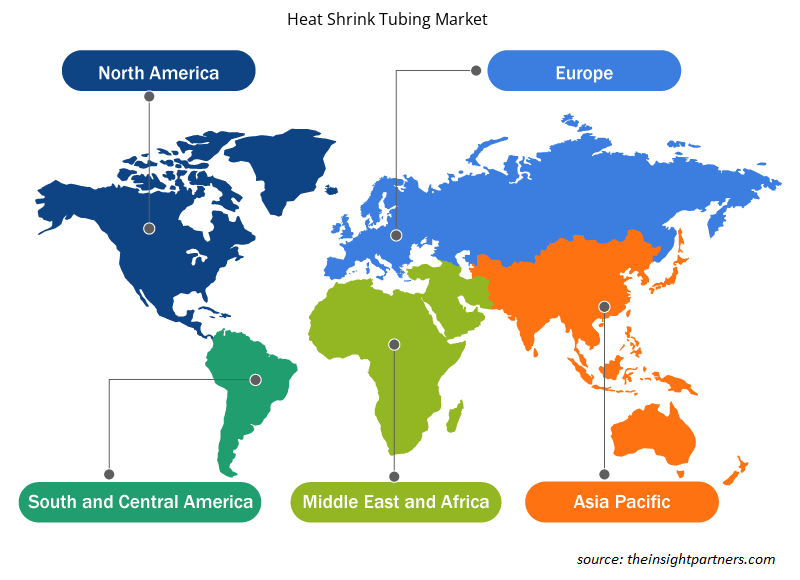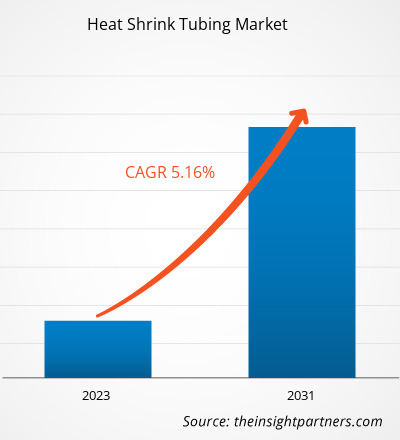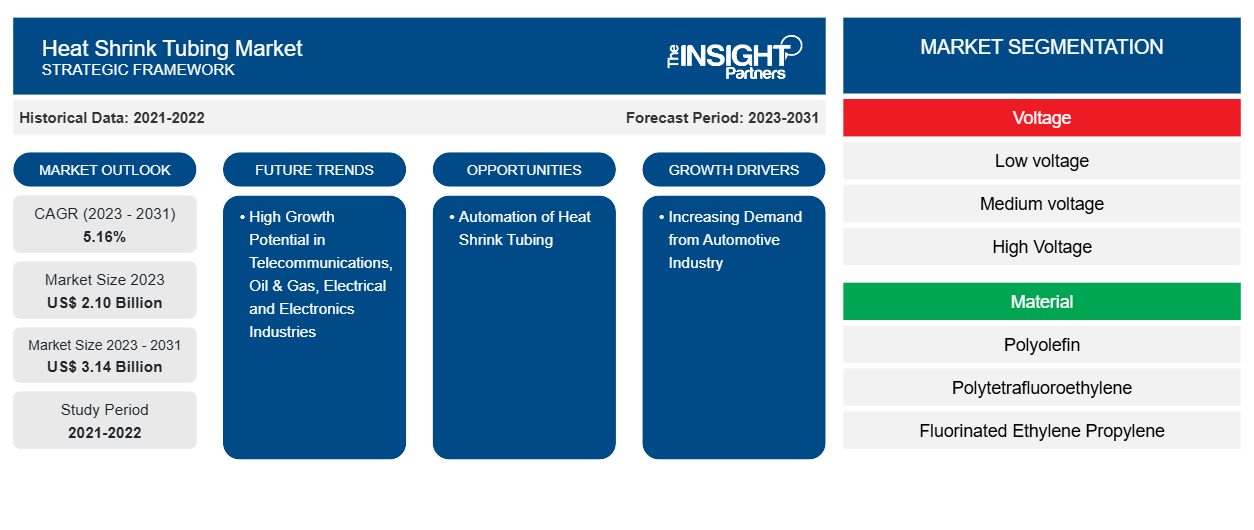Si prevede che il mercato dei tubi termorestringenti raggiungerà i 3,14 miliardi di dollari entro il 2031 dai 2,10 miliardi di dollari del 2023, con un CAGR del 5,16% entro il 2031. La crescente domanda da parte dell'industria automobilistica e le iniziative governative per aggiornare i sistemi di trasmissione ed espandere la distribuzione sono tra i principali fattori che guidano la crescita del mercato. Inoltre, l'elevato potenziale di crescita da settori come l'elettricità e l'elettronica, le telecomunicazioni e il petrolio e il gas offre opportunità di crescita redditizie per il mercato. Si prevede che l'automazione del processo dei tubi termorestringenti emergerà come una tendenza nel mercato durante il 2023-2031.
Analisi di mercato dei tubi termorestringenti
I principali stakeholder nell'ecosistema di mercato includono fornitori di materie prime, produttori di tubi termorestringenti e clienti o utenti finali. Il fornitore di materie prime è uno stakeholder cruciale nell'ecosistema del mercato. Le parti principali dei tubi termorestringenti includono materiali come poliolefina, politetrafluoroetilene, etilene propilene fluorurato, perfluoro alcossi alcano, polivinilidene fluoruro e altri.
Panoramica del mercato dei tubi termorestringenti
I produttori di tubi termorestringenti producono il prodotto in base ai requisiti del settore, compatibile con un'ampia gamma di applicazioni. Le aziende di tubi termorestringenti si stanno concentrando sempre di più sul miglioramento dell'efficienza e dell'autonomia delle batterie potenziando l'infrastruttura di ricarica. La presenza di un gran numero di produttori di tubi termorestringenti sta competendo su larga scala principalmente in base a materiali avanzati e disponibilità di presenza in tutto il mondo. Include 3M, Shenzhen Woer Heat Shrinkable Material Co., Ltd; TE Connectivity e Sumitomo Electric Industries, Ltd tra gli altri attori.
Personalizza questo report in base alle tue esigenze
Riceverai la personalizzazione gratuita di qualsiasi report, comprese parti di questo report, o analisi a livello nazionale, pacchetto dati Excel, oltre a usufruire di grandi offerte e sconti per start-up e università
-
Scopri le principali tendenze di mercato in questo rapporto.Questo campione GRATUITO includerà analisi di dati che spaziano dalle tendenze di mercato alle stime e alle previsioni.
Driver e opportunità del mercato dei tubi termorestringenti
Domanda crescente da parte dell'industria automobilistica
Con la crescente tendenza dei veicoli elettrici, la crescente necessità di elettrodomestici cablati sta dando impulso al mercato. Il tubo termorestringente in un veicolo elettrico viene utilizzato in molte applicazioni per la schermatura dei cavi dalla presa di ricarica ai componenti elettrici in tutto il cruscotto del veicolo, il sistema tergicristallo, il sistema di illuminazione, il sistema di chiusura centralizzata, il sistema acustico, il sistema di aria condizionata e così via.
Elevato potenziale di crescita nei settori delle telecomunicazioni, del petrolio e del gas, dell'elettricità e dell'elettronica
I tubi termorestringenti hanno vari usi e sono ampiamente utilizzati nei cavi di rete per telecomunicazioni. I tubi termorestringenti sono utilizzati per proteggere queste connessioni, cavi, conduttori, giunti e terminali dai danni ambientali. Inoltre, l'industria petrolifera e del gas affronta gli effetti e le condizioni ambientali più difficili. Calore estremo, corrosione, pressione e altri fattori influenzano le apparecchiature utilizzate nell'industria petrolifera e del gas. I tubi termorestringenti assicurano che le apparecchiature forniscano prestazioni costanti e affidabili. Pertanto, la domanda di tubi termorestringenti nei settori delle telecomunicazioni, petrolifero e del gas e nei settori elettrico ed elettronico offre ampie opportunità di crescita del mercato.sures the equipment delivers consistent and reliable performance. Thus, the demand for heat shrink tubing across telecommunications, oil & gas, and electrical & electronics industries provides ample opportunities for market growth.
Analisi della segmentazione del rapporto di mercato sui tubi termorestringenti
I segmenti chiave che hanno contribuito alla derivazione dell'analisi di mercato sono tensione, materiale e utente finale.
- In base alla tensione, il mercato è suddiviso in Bassa tensione (inferiore a 5 kV), Media tensione (5-35 kV) e Alta tensione (superiore a 35 kV). Il segmento della bassa tensione (inferiore a 5 KV) ha detenuto una quota di mercato maggiore nel 2023.
- In base al materiale, il mercato globale dei tubi termorestringenti è suddiviso in poliolefina, politetrafluoroetilene, etilene propilene fluorurato , perfluoro alcossi alcano, polivinilidenfluoruro e altri. Il segmento delle poliolefine ha detenuto una quota di mercato maggiore nel 2023.
- A seconda dell'utente finale, il mercato globale è suddiviso in Energia, Servizi di pubblica utilità, Energia elettrica, Infrastruttura/Costruzione di edifici, Industriale, Telecomunicazioni, Automotive, Aerospaziale, Difesa, Trasporto pubblico e mobilità, Medicina, Petrolchimica e Minerario. Il segmento dei servizi di pubblica utilità ha detenuto una quota di mercato maggiore nel 2023.
Analisi della quota di mercato dei tubi termorestringenti per area geografica
L'ambito del rapporto di mercato sui tubi termorestringenti comprende Nord America (Stati Uniti, Canada e Messico), Europa (Spagna, Regno Unito, Germania, Francia, Italia e resto d'Europa), Asia Pacifico (Corea del Sud, Cina, India, Giappone, Australia e resto dell'Asia Pacifico), Medio Oriente e Africa (Sudafrica, Arabia Saudita, Emirati Arabi Uniti e resto del Medio Oriente e Africa) e Sud e Centro America (Brasile, Argentina e resto del Sud e Centro America). In termini di fatturato, l'APAC ha dominato la quota di mercato dei tubi termorestringenti nel 2023. Il Nord America è il secondo maggiore contributore al mercato globale dei tubi termorestringenti, seguito dall'Europa.
Approfondimenti regionali sul mercato dei tubi termorestringenti
Le tendenze regionali e i fattori che influenzano il mercato dei tubi termorestringenti durante il periodo di previsione sono stati ampiamente spiegati dagli analisti di Insight Partners. Questa sezione discute anche i segmenti e la geografia del mercato dei tubi termorestringenti in Nord America, Europa, Asia Pacifico, Medio Oriente e Africa e America centrale e meridionale.

- Ottieni i dati specifici regionali per il mercato dei tubi termorestringenti
Ambito del rapporto di mercato sui tubi termorestringenti
| Attributo del report | Dettagli |
|---|---|
| Dimensioni del mercato nel 2023 | 2,10 miliardi di dollari USA |
| Dimensioni del mercato entro il 2031 | 3,14 miliardi di dollari USA |
| CAGR globale (2023-2031) | 5,16% |
| Dati storici | 2021-2022 |
| Periodo di previsione | 2023-2031 |
| Segmenti coperti |
Per voltaggio
|
| Regioni e Paesi coperti |
America del Nord
|
| Leader di mercato e profili aziendali chiave |
|
Densità dei protagonisti del mercato dei tubi termorestringenti: comprendere il suo impatto sulle dinamiche aziendali
Il mercato dei tubi termorestringenti sta crescendo rapidamente, spinto dalla crescente domanda degli utenti finali dovuta a fattori quali l'evoluzione delle preferenze dei consumatori, i progressi tecnologici e una maggiore consapevolezza dei vantaggi del prodotto. Con l'aumento della domanda, le aziende stanno ampliando le loro offerte, innovando per soddisfare le esigenze dei consumatori e capitalizzando sulle tendenze emergenti, il che alimenta ulteriormente la crescita del mercato.
La densità degli operatori di mercato si riferisce alla distribuzione di aziende o società che operano in un particolare mercato o settore. Indica quanti concorrenti (operatori di mercato) sono presenti in un dato spazio di mercato in relazione alle sue dimensioni o al valore di mercato totale.
Le principali aziende che operano nel mercato dei tubi termorestringenti sono:
- HellermannTyton
- Azienda: Sumitomo Electric Industries, Ltd.
- Associazione Molex LLC
- 3 milioni
- Shenzhen Woer Heat - Shrinkable Material Co., Ltd
- Shanghai Changyuan Electronic Material Co., Ltd
Disclaimer : le aziende elencate sopra non sono classificate secondo un ordine particolare.

- Ottieni una panoramica dei principali attori del mercato dei tubi termorestringenti
Notizie e sviluppi recenti sul mercato dei tubi termorestringenti
Il mercato viene valutato raccogliendo dati qualitativi e quantitativi dopo la ricerca primaria e secondaria, che include importanti pubblicazioni aziendali, dati associativi e database. Di seguito è riportato un elenco degli sviluppi nel mercato per innovazioni, espansione aziendale e strategie:
- Nel marzo 2024, Junkosha, specialista dei materiali e pioniere del tubo termorestringente staccabile in FEP (PHST), ha presentato la sua ultima innovazione basata su catetere, la soluzione Translucent PHST con rapporto di restringimento 1,8:1, alla fiera MD&M West dal 6 all'8 febbraio 2024. (Fonte: Junkosha, comunicato stampa)
Copertura e risultati del rapporto sul mercato dei tubi termorestringenti
Il rapporto "Dimensioni e previsioni del mercato dei tubi termorestringenti (2021-2031)" fornisce un'analisi dettagliata del mercato che copre le seguenti aree:
- Dimensioni del mercato dei TUBI TERMORESTRINGENTI e previsioni a livello globale, regionale e nazionale per tutti i principali segmenti di mercato interessati dall'ambito.
- Dinamiche di mercato come fattori trainanti, vincoli e opportunità chiave
- Tendenze del mercato dei TUBI TERMORESTRINGENTI
- Analisi dettagliata delle cinque forze PEST/Porter e SWOT
- Analisi di mercato dei TUBI TERMORESTRINGENTI che copre le principali tendenze del mercato, il quadro globale e regionale, i principali attori, le normative e i recenti sviluppi del mercato
- TUBI TERMORESTRINGENTIAnalisi del panorama industriale e della concorrenza che comprende concentrazione del mercato, analisi della mappa termica, attori principali e sviluppi recenti.
- Profili aziendali dettagliati
- Analisi storica (2 anni), anno base, previsione (7 anni) con CAGR
- Analisi PEST e SWOT
- Valore/volume delle dimensioni del mercato - Globale, Regionale, Nazionale
- Industria e panorama competitivo
- Set di dati Excel
Report recenti
Testimonianze
Motivo dell'acquisto
- Processo decisionale informato
- Comprensione delle dinamiche di mercato
- Analisi competitiva
- Analisi dei clienti
- Previsioni di mercato
- Mitigazione del rischio
- Pianificazione strategica
- Giustificazione degli investimenti
- Identificazione dei mercati emergenti
- Miglioramento delle strategie di marketing
- Aumento dell'efficienza operativa
- Allineamento alle tendenze normative























 Ottieni un campione gratuito per - Mercato dei tubi termorestringenti
Ottieni un campione gratuito per - Mercato dei tubi termorestringenti